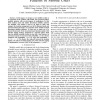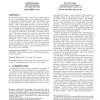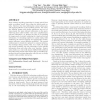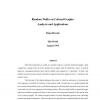SODA
2008
ACM
14 years 4 months ago
2008
ACM
Jim Propp's rotor router model is a deterministic analogue of a random walk on a graph. Instead of distributing chips randomly, each vertex serves its neighbors in a fixed or...
EURONGI
2008
Springer
14 years 4 months ago
2008
Springer
In this paper, we propose a new mobility model as an extension of the random walk model. Our proposal gathers mobility patterns with several degrees of randomness, so that both ran...
DIALM
2008
ACM
14 years 4 months ago
2008
ACM
In opportunistic forwarding, a node randomly relays packets to one of its neighbors based on local information, without the knowledge of global topology. Each intermediate node co...
WSC
2007
14 years 5 months ago
2007
We consider the problem of efficient estimation of first passage time probabilities for a multidimensional random walk with t distributed increments, via simulation. In addition...
CIVR
2010
Springer
14 years 5 months ago
2010
Springer
Most existing reranking approaches to image search focus solely on mining "visual" cues within the initial search results. However, the visual information cannot always ...
ECAI
2006
Springer
14 years 6 months ago
2006
Springer
Some of the most successful algorithms for satisfiability, such as Walksat, are based on random walks. Similarly, local search algorithms for solving constraint optimization proble...
KDD
2010
ACM
14 years 7 months ago
2010
ACM
Many recommendation and retrieval tasks can be represented as proximity queries on a labeled directed graph, with typed nodes representing documents, terms, and metadata, and labe...
STOC
1992
ACM
14 years 7 months ago
1992
ACM
How much can an imperfect source of randomness affect an algorithm? We examine several simple questions of this type concerning the long-term behavior of a random walk on a finite...
ISTCS
1993
Springer
14 years 7 months ago
1993
Springer
This thesis introduces a model of a random walk on a colored undirected graph. Such a graph has a single vertex set and distinct sets of edges, each of which has a color. A par...
RT
1998
Springer
14 years 7 months ago
1998
Springer
The paper presents a single-pass, view-dependent method to solve the general rendering equation, using a combined finite element and random walk approach. Applying finite element t...




